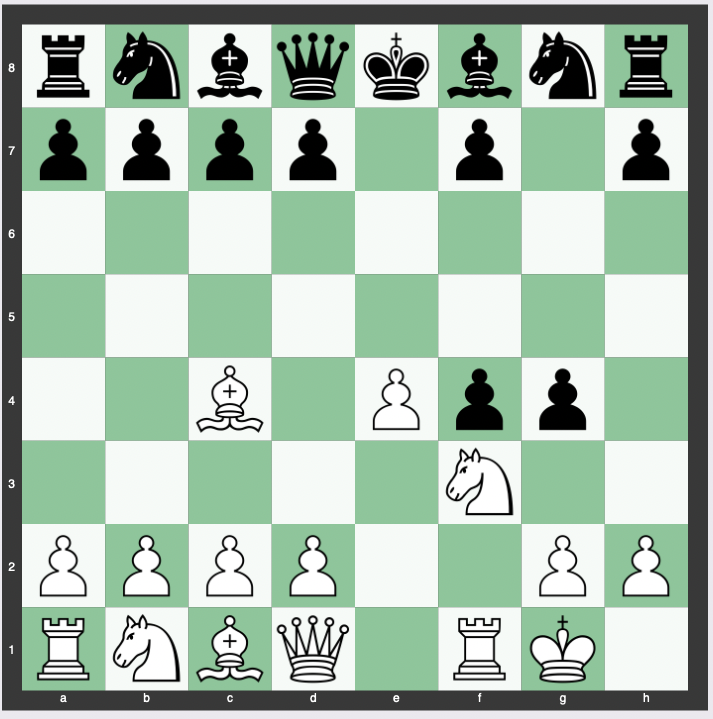The Muzio Gambit, also referred to as the Polerio Gambit, is an aggressive and tactical chess opening that occurs in the King’s Gambit.
The white player sacrifices a knight to rapidly develop their pieces and launch an attack.
The objective of this gambit is to exploit black’s weakness on the f-file. While it offers an exciting and dynamic game, it demands precise play from both sides.
The Muzio Gambit Moves (Move Order)
The Muzio Gambit starts with the following move order:
- e4 e5
- f4 exf4
- Nf3 g5
- Bc4 g4
- 0-0

White intentionally offers a knight, capitalizing on the f-file’s vulnerability to strike at the black king.
Other 5th move possibilities for White include 5.Bxf7+ (Lolli Gambit), 5.Nc3 (McDonnell Gambit), 5.d4 (Ghulam Kassim Gambit), 5.h4 (Australian Gambit), and 5.Ne5 (Salvio Gambit).
However, the 5.0-0 move is generally regarded as White’s strongest option.
The Encyclopedia of Chess Openings assigns code C37 to the Muzio Gambit.
Evaluation of the Muzio Gambit
The Muzio Gambit is generally evaluated at around -1.15 to -1.60 for white.
Continuation lines might include:
5… gxf3 6. Qxf3 Qf6 7. d3 Nc6 8. Bxf4 d6 9. Nc3 Qg7 10. Nd5 Kd8 11. Bg3 Ne5 12. Qf2 Be6 13. Bh4+ Kc8 14. Rae1 Nxc4 15. dxc4 a5 16. c5 Ra6 17. Rd1 h5 18. Rd3 Bxd5 19. Rxd5
5… gxf3 6. Qxf3 Qf6 7. d3 Nc6 8. Bxf4 d6 9. Nc3 Qg7 10. Nd5 Kd8 11. Bg3 Ne5 12. Qe3 Be6 13. Bh4+ Kd7 14. Nf6+ Nxf6 15. Bxe6+ fxe6 16. Bxf6 Qh6 17. Qg3 Be7 18. Bxh8 Rxh8 19. d4 Nc6 20. c3 Nd8
5… gxf3 6. Qxf3 Qf6 7. d3 Nc6 8. Bxf4 d6 9. Nc3 Qg7 10. Nd5 Kd8 11. Bg3 Ne5 12. Qe3 Be6 13. Bb3 Ne7 14. Nf4 Bxb3 15. axb3 N5g6 16. Rxa7 Rxa7 17. Qxa7 Nxf4 18. Rxf4 Qxb2 19. Rxf7 Qc1+ 20. Rf1 Qxc2 21. Qxb7 Kd7
History of the Muzio Gambit
The opening was first analyzed by Giulio Cesare Polerio in the late 16th century.
The first documented game featuring this opening was played by Geronimo Cascio and published in Alessandro Salvio’s “Il Puttino” in 1634.
The name “Muzio Gambit” is attributed to the 19th-century English chess writer Jacob Sarratt, who mistakenly associated the opening with Mutio d’Allesandro, a contemporary of Cascio, in his translation of “Il Puttino”.
The Muzio Gambit was particularly popular during the mid-19th century, the Romantic era of chess, when bold sacrifices and early attacks were highly esteemed.
Its popularity waned with the improvement of defensive techniques by players like Louis Paulsen and Wilhelm Steinitz, but it can still be seen, especially at amateur levels.
Analysis of the Muzio Gambit
The typical Muzio Gambit continues with these moves:
- e4 e5
- f4 exf4
- Nf3 g5
- Bc4 g4
- 0-0 gxf3
- Qxf3 Qf6
The main variations occur after the 7th move by White, which could be either 7. e5 or 7. d3.
The Double Muzio Gambit starts with 8. Bxf7+. Alternatively, if White plays 8. d3, it leads to the Main line of the Muzio Gambit.
Muzio Gambit (Handle with care!) | King’s Gambit Opening Theory
Double Muzio Gambit
The Double Muzio Gambit is triggered by 8.Bxf7+.
It is widely recognized as a dangerous strategy against an unprepared opponent, although its soundness has been questioned.
Attempting The Double Muzio Gambit (Twice!)
Main Line: 8.d3
The main line, characterized by the move 8.d3, continues as follows:
- d3 Bh6
- Nc3 Ne7
- Bd2 Nbc6
- Rae1 Qf5!
This specific move (11… Qf5!) was first proposed in 1858 by a player known only as “W.S.”, marking a significant development in the understanding of the Muzio Gambit.
Other 8th Moves for White
There are other possible 8th moves for White, although they may not be as strong as the main choices.
For instance, 8.b3 and 8.Nc3 have been played, but these usually lead to a preferable position for Black.
Conclusion
The Muzio Gambit is a dynamic and aggressive opening that requires both players to tread carefully.
It offers an exciting game of chess full of tactical possibilities, but it demands accuracy and confidence.
The Muzio Gambit, with its rich history and analytical depth, showcases the beauty of chess as a game where strategic planning, bold attacks, and tactical intricacies combine to create a thrilling battle of minds.


